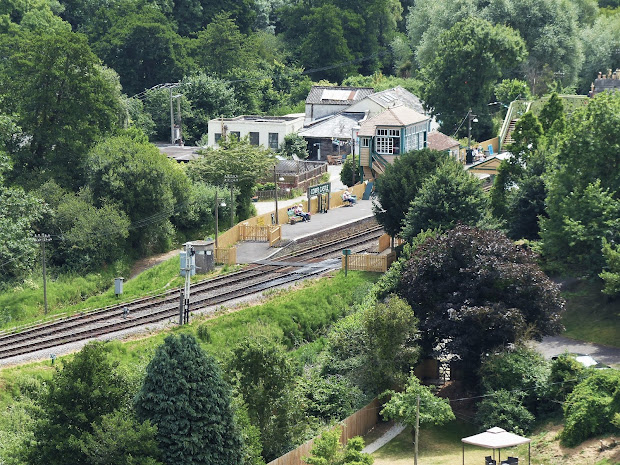The tiny village of Corfe is famous for one thing only, Corfe Castle. This magnificent ruin stands high above the village giving a clear view of the land around. Those coming by boat or land through the Purbeck Hills could not avoid detection from the defenders. Purbeck of course was famous for the marble quarried here, the 'Isle of Portland' also famous for the stone that was used worldwide. This is likely to have been used as a defensive site from very early on, it is thought Romans used it and certainly the Anglo-Saxons built a wooden fort of some sort before in the late 11th century those Norman chaps made use of the stone and encouraged the local labour folks to help them, and a man with a big stick is indeed an encouragement to work!
The English Civil War, which was not I understand very civil at all, found the then owners, Sir John and Lady Bankes on the side of the monarchy and almost the whole of Dorset parliamentarian. After his death in 1644 the castle was again subject to siege and was taken by treachery and the parliamentarians destroyed the castle making it unfit for purpose, however it was not by that time as effective as it had once been. The Bankes family continued to own but not live in the castle handing it over to the nation in 1982. A nice tourist trap which we did not have time to visit but a few million photos were taken.

I am not sure who took all the fotos, however this one does show something of the normal Norman style. In the middle was the solid square 'Keep' which rose three or four stories, the walls around and with rounded towers to aid defence. It is noticeable how much some of the walls now lean at angles, not much use when defending yourself. I would have got closer pictures but a woman would have asked me to pay so I stayed at a distance, I did however get permission from the various bodies concerned for this picture. Note the slight haze seen from a distance, this covered the land and could be seen from the ridge above but not once in the village itself.

Corfe itself is basically two streets, East Street, the main road, and West Street which isn't. The masses of tourists, and the place is so small a 'mass' quickly forms, find a post office with a friendly man in control, several pubs, a castle, a church and houses. It is clear an effort has been made to keep the 'tacky' elements of tourism to a minimum, well done Corfe! In the middle stands a cross erected in 1897 commemorating Queen Victoria's Diamond Jubilee, it makes a good place for tourists to block the centre of town! The old houses and major buildings are all made of Purbeck stone as indeed are the walls around the farms. These give a grandeur to the villages we passed through and reflect something of the wealth amassed in times past, long before further down the road Swanage was important.
This part of England is called the 'Jurassic Coast' because of the fossils and remnants of dinosaurs that once roamed the area. Cue jokes from women re their men at this point. Certainly women living here around 6000BC would have said such things, probably with as much reason. In those days people would follow the herds of deer from around here and walk all the way to what is now northern Germany. Once the North Sea arrived they were trapped on this island and how their life must have changed. Celts, Romans, Vikings, Normans and all have lived here at one time down to the present occupants of the land. The present population affected, even though they may not recognise this, by all those who have gone before. As many of England's Kings and their families made use of the castle the small village may well have seen many famous people pass through - for the last time, you know how blood thirsty English royalty can be.

We did not have much time here, a quick poke around the two streets, the church, the Post Office for stamps and a look at the houses, some of which contain bits taken from the ruined castle, and not even a sight of the steam railway that runs through here from Swanage, and we missed the train there also.
The church had one of these beasties on each corner high above. How old they are and who made them I know not, probably a Victorian I guess, but each was different and ready to send rain water on passers-by.
Among the passers-by are many hikers and cyclists as this part of the world attracts tourists who like the sea and country, a great change from the city many are forced to inhabit. However the hills are just that and we saw one example of equality where a couple walked their bikes up the steep slope, that is she waked he pushed both bikes. Typical woman! The area is good for fit cyclists so I would avoid it but the views from the ridge are excellent.
.

































